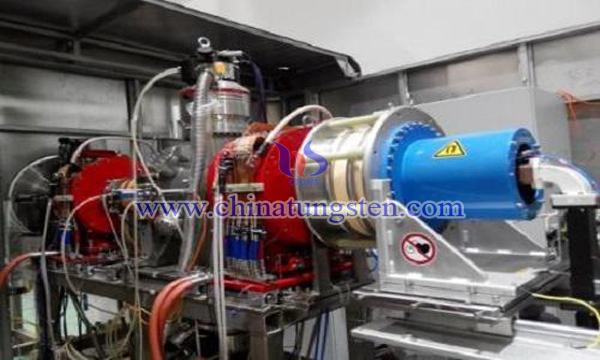Upgrading of Tungsten Alloy Detection Technology Assisted by the Strongest Deuterium-tritium Neutron Source
- Details
- Category: Tungsten's News
- Published on Wednesday, 28 November 2018 22:50
According to Sci-tech Daily on February 1, researchers from the FDS Fenglin Nuclear Energy Team of the Institute of Nuclear Energy Safety Technology of the Chinese Academy of Sciences have made breakthroughs in the physics and technology of neutron transport. The team developed HINEG, a high-current deuterium-tritium neutron source experimental device, in which the intensity of neutron source is the first in the world.

According to the researchers, neutrons are the "soul" to maintain the safe operation and control of nuclear energy system, but neutrons themselves are not charged and can not be controlled by electromagnetic field like electrons and protons, which requires precise theoretical methods and technology to achieve. Neutron source is the necessary experimental platform for studying nuclear energy and nuclear safety technology. Deuterium-tritium fusion neutron source bombards deuterium target with deuterium ion beam produced by accelerator, and produces 14 megavolt (MeV) monoenergetic neutrons by deuterium-tritium fusion reaction. This is a necessary experimental platform for neutron method program and verification of nuclear data, radiation shielding and protection, material activation and radiation damage components. The final results of this research can also be applied in the fields directly related to national economy and people's lives, such as nuclear medicine and radiotherapy, nuclear logging and prospecting, fast neutron radiography, medical isotope production, fast neutron activation analysis, etc., to achieve research and application, and to promote the development of new industrial technology. So how will HINEG help tungsten alloy testing technology upgrade? Here, Xiaobian first explains a technology called "non-destructive testing".
In material and product testing, there is a technology called non-destructive testing. The application of this technology can check whether there is a quality problem on the surface of materials and products, and can accurately locate the location and specific information of the problem, so as to facilitate people to improve and manufacture in a targeted manner, and minimize the problem. Non-destructive testing will not destroy the performance of products or materials and ensure their integrity, so that non-destructive testing can be applied to detect defects of the detected objects. The application of non-destructive testing can reduce costs and improve product quality and work efficiency.
The main methods of non-destructive testing include ultrasonic testing, magnetic particle testing, penetration testing, eddy current testing and X-ray testing. For metals, X-ray testing is the most important means of detection. Although X-rays can penetrate metal materials, if the material is very thick, the rays will weaken as the thickness increases. Moreover, tungsten alloy is a natural high-density shielding material, X-ray is difficult to penetrate and detect. Furthermore, X-rays can cause radiation to the human body and are not suitable for long-term operation.

So, what field of tungsten alloy materials must be used for non-destructive testing? There are also a lot of tungsten alloy parts in aerospace industry, nuclear power plant, the first wall material of ITER artificial sun, tungsten divertor and so on. These facilities are facing the harsh environment or temperature near the limit. They require very high application requirements for tungsten alloy materials and must ensure the highest performance and level. Therefore, the most precise non-destructive testing technology is needed to test products to ensure that tungsten alloy parts are safe.
HINEG can solve this problem. It is known that HINEG has the function of neutron photography. It is a "micro-detection" technology to detect the internal micro-structure of substances. It can be regarded as an evolutionary upgrade of X-ray. It uses the difference of neutron penetration ability in different substances to penetrate the internal structure of objects and detect hydrogen-containing materials. The structure of heavy metal components such as tungsten alloys and radioactive materials make up for the shortcomings of other non-destructive testing technologies such as X-ray. The intense neutron beam generated by HINEG can be used for high precision nondestructive testing, and can promote the rapid development of aerospace, new energy and other fields in China.
It is worth mentioning that neutron radiography technology can not only be used for nondestructive testing of tungsten alloy materials, but also for cancer treatment. This method is a bio-targeted radiotherapy mode with inherent safety. It has little damage to normal tissues of patients, can effectively improve the quality of life of patients, and initiates human conquering evil. A new approach to sexual tumors. In the field of cancer, the 20th century can be said to be the century of X-ray, and the 21st century will be the century of neutron therapy, according to internationally renowned experts. HINEG can be used as an important platform for the research of neutron cancer treatment technology, and will also promote the development of neutron cancer treatment in China. (China Tungsten Online: Weiping)
- Tungsten Alloy Manufacturer & Supplier, Chinatungsten Online: www.tungsten-alloy.com
- Tungsten News & Prices of China Tungsten Industry Association: www.ctia.com.cn
- Molybdenum News & Price: news.molybdenum.com.cn
- Tel.: 86 592 5129696; Fax: 86 592 5129797; Email: sales@chinatungsten.com